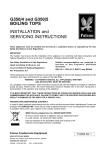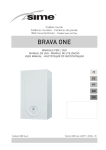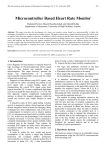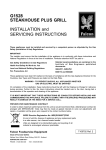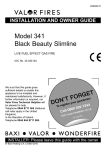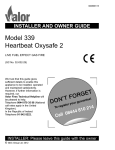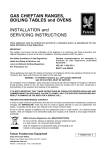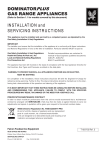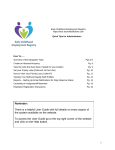Download Toy Safety Instructions No (7) for 2008 Issued According to
Transcript
Toy Safety Instructions No (7) for 2008 Issued According to Article (5-a-13) & Article (8-c) of the Standards and Specifications Law No 22 for 2000 Article (1) The instructions herein shall be hereinafter named Safety Instructions No (7) for 2008. Chapter (1) Definitions Article (2) The following terms and phrases shall have the following meanings, unless otherwise indicated: - Association: - Council: - General Manager: - Toy: Standards & Specifications Association Association Board of Directors Association General Manager Any product or item designed for or clearly intended to be played with by children of not more than 14 years of age. Chapter (2) Scope Article (3) The herein instructions apply to all toys, with the exception of the follow ing products: - Items used as decorations for celebrations or festivals; Miniatures designed as toys for adult assembly; Equipment for collective use at playgrounds; Sporting equipment; Water sport equipment designed for use in deep waters; Popular puppets and dolls similar to adult assembly toys; - Professional assembly toys in public places (shopping malls, play areas, etc.); - Puzzles comprising more than 500 pieces, or puzzles without illustrating pictures specifically for professionals; - Air guns and pistols; - Fireworks that encompass spark capsules; - Slingshots and other tools for projecting stones; - Electric ovens, irons or similar products that operate using nominal voltage exceeding 24 volts; - Equipment with heating components for use under adult superv ision in an educational environment; - Vehicles with combustion engines; - Toy steam engines; - Bicycles designed for sports or travel on public roads; - Games that are connected to a television screen and use a nominal voltage of more than 24 volts; - Fake statues for children; - Remanufacturing of genuine firearms; - Children’s decorative jewellery. Chapter (3) Fundamental Safety Requirements Article (4) The instructions herein state the following fundamental safety requirements, which must be available in children’s toys. The instructions include general hazards (such as protection from dangers that might affect the health or lead to physical harm), and specific hazards (such as physical or mechanical features, inflammability, chemical specifications, electric specifications, healthcare and hygiene, and radioactivity). 4-1 General Hazards 4-1-1 Toy users must be protected from hazards that might affect their health, or lead to inflicting bodily harm upon using them according to the prescribed or foreseen methods, considering normal child behaviour. Such hazards include: - Hazards related to the design, assembly, or components of the toy; - Inherent hazards of using the toy that cannot be totally removed through modifying the toy structure and components with out altering the function of the toy or removing its essential components. 4-1-2 The level of hazard associated with using the toy must correspond to the ability of its users and supervisors, when appropriate to address the hazard level. This concept applies to toys that are by default prepared for use by children under the age of 36 months. 4-1-3 The minimum age of toy users must determined, and/or the need to ensure its use only under adult supervision when necessary, so as to monitor the enforcement of this concept. 4-1-4 The toy user manual, and/or packaging material and packaging attached to the toys must actively and fully indicate to the users or supervisors the hazards that may ensue from using such toys, in addition to stipulating methods for preventing such hazards from occurring. 4-2 Specific Hazards 4-2-1 Physical and Mechanical Features: - Where appropriate, all toy components, and fixtures in cases of fixed playing, must entail the required mechanical strength and stability to endure the pressure to which the toys are subjected when in use without breaking or disfiguration, which would consequently result in the risk of bodily harm to the user; - All edges, uneven surfaces, ropes cables, and stalls that are accessible in toys must be designed and assembled so as to reduce to a minimum the risk of bodily harm resulting from contact with the toy; - In addition to any other part that may be detached from the toy, dimensions and components clearly designed for use by children aged less than 36 months must be reasonably designed to prevent them from being swallowed and/or inhaled; - Toys must be designed and assembled in a manner that reduces the risk of bodily harm that may result from moving the different parts of the toy. - Toys, components of toys and packaging materials must not pose, upon retail sale, any risk of suffocation or causing suffocation; - Toys designed and assembled to hold up or assist children in shallow waters should be designed in a manner that reduces as far as possible any risks related to losing floating capability or losing support provided to a child, considering the recommended nature for use of the toy; - Toys that are accessible and which form an enclosure to the user must have an exit that can be easily opened from inside; - Toys that provide mobility to users must have a braking system that should be, as far as possible, in line with the mobile energy resulting from this system. The braking system must be easy to operate by users and must not cause any risk of bodily harm or ejection to the user; - The shape and assembly of projectiles and the kinetic power produced by a toy upon firing an object from a toy designed for this purpose must not constitute any unreasonable risk of bodily harm to the user, considering th e nature of the toy; - Toys must be designed without any heating components, so as to ensure that: 1. The maximum temperature of any accessible surface does not cause burns upon touching the toy; 2. The temperature, or the liquid or gas pressure containe d in a toy, must not reach a level of leakage unless for reasons related to the correct operation of the toy, given that the leakage of such equipment may lead to burns, combustion or other physical injuries. 4-2-2 Flammability - Toys must not contain any flammable components within the environment of a child. Consequently, toys must: 1. Be inflammable upon direct exposure to sparks or flames or any other source of fire; 2. Be easily extinguished (flame disappears when the cause of fire is no longer valid); 3. Burn slowly when set alight, provided the disbursement of flames is low; 4. Be treated in a way that leads to the delay of combustion regardless of the chemical components in the toy. Flammable materials within a toy must not pose any threat of ig niting other materials used in the product. - The toys may not contain any hazardous components or items, unless where necessary for the correct operation of the toy, particularly items and equipment used for chemical experiments, assembly of models, mouldi ng of plastic or ceramics, paints, photography, or any other similar activities where the presence of such items or components may result in a flammable toy ensuing from the loss of volatile inflammable components. - Toys must not be explosive or encompass tetryl materials when used in a designed or expected manner, considering normal child behaviour. This condition does not apply to triggering firework capsules. - Toys, particularly toys intended as chemical games, may not have any materials that: 1. May explode upon mixing; 2. Explode during a chemical reaction or by heating; 3. Explode when mixed with oxidising material; 4. Contain volatile components that are flammable in the air, which could forge a flammable explosive mixture of air/vapour. 4-2-3 Chemical Features - Toys must be designed or assembled so as not to pose health hazards or risk of bodily injuries by means of consumption through the mouth, inhaling, touching the skin or mucosa or eyes upon correct or expected use, considering the natural behaviour of children. - For purposes of protecting children’s health, the bio availability resulting from using toys should be the following levels per day: 1. Antimone 0.2 Microgram 2. Arsenic 0.1 Microgram 3. Barium 25.0 Microgram 4. Cadmium 0.6 Microgram 5. Chrome 0.3 Microgram 6. Lead 0.7 Microgram 7. Mercury 0.5 Microgram 8. Selenium 5.0 Microgram The bio availability of the above components means the diluted extract of a toxic indication. - Toys must not entail any hazardous materials in quantities that may h arm the health of the child using the toy. In all cases, it is categorically prohibited to have any hazardous items or materials in toys, if such materials are prepared for use in the same manner as a toy when a limited number of materials or items is nec essary for the function of certain toys; particularly materials used for chemical experiments, assembly of models, moulding of plastic or ceramics, paints, photography, or any other similar activity through which such materials are allowed in maximum concentrations set by the Jordanian Standards and Specifications related to children toys. 4-2-4 Electric Specifications - Electric toys or any component inside a toy must not be operated using a nominal voltage exceeding 24 volts. - All mechanical part of the toy that may be connected to an electric source and which is capable of producing an electric shock in addition to the cables and other electric conductors must be properly insulated and protected to prevent all risk of electric shock. - Electric toys must be designed and assembled so as to ensure that the maximum temperature of surfaces that are directly accessible do not cause burns upon touching them. 4-2-5 Health Care Toys must be designed and manufactured so as to fulfil health and hygiene requirements, so as to avert the hazards of contamination, contagion, and illnesses. 4-2-6 Radioactivity Toys must not contain any radioactive materials or components, in any form or percentage that may be harmful to children as per the national legislatio ns issued to that end. Chapter (4) Warnings and Cautions Article (5) Clear and readable warnings and cautions must be affixed to toys, so as to reduce dangers ensuing from using the toy as set out in Article (4) above, particularly: 5-1 Toys for children under the age of 36 months: Toys that are hazardous for children under the age of 36 months must bare a warning sign, such as “Not suitable for children under 36 months old”, or “Not suitable for children under 3 years of age”, while adding a brief o n the specific hazards related to the affixed warning, which may also appear on the user manual. The said requirements do not apply to toys that are, by default, dimensions, specifications, features, or any other reasonable cause clearly unsuitable for children under the age of three. 5-2 Skates, hanging swings or ferrules, sport swings, ropes and similar toys attached to a crossing beam: Instructions that draw attention to the need of maintaining the principal parts within fixed intervals must be attache d to such toys (i.e. fixtures, ropes, wings, etc.), while stressing that failure to undertake the above measures shall lead to the fall or overthrow the user. Specific instructions must also stipulate the correct assembly of the toy, while indicating any p arts that could be hazardous if assembled incorrectly. 5-3 Functional Toys Functional toys, or the packaging therein, must entail cautionary signs stipulating the need to use the toys under direct adult supervision. Further, instructions related to preventive measures and operation must be provided to the user in the form of caution stickers, which are normally attached to the tool or product, when the toy is a miniature or an imitation. The caution sign must also stipulate that such toys must be kept out of the reach very young children. Functional toys means toys that are used in the same manner or assembly as adult toys, while in most cases such toys are only miniatures of the aforementioned. 5-4 Toys Containing Ground Hazardous Materials (Chemical To ys) a) Toys containing ground hazardous materials must bare a warning of the nature of such materials or items, while stipulating preventive measures to be considered by the user to avert the dangers associated with such materials, and briefly state them a ccording to the toy type. In case of serious accidents ensuing from using this type of toy, first aid instructions must be provided, in addition to an indication that the toys must be kept away from the reach of small children. b) In addition to the instructions stated in sub-paragraph 5-4-a, chemical toys must bare a warning sign indicating that such toys should only be used by children over the age set out by the manufacturer, and under the direct supervision of adults. 5-5 Slides and Children Skate Boards Such products must bare warning signs indicating the need to wear protective equipment. User instructions must also entail warnings stipulating that caution should be taken in using such toys, as they require the user to have the necessary skills for averting accidents or falls that may inflict harm upon them. It is recommended that the need to use protective gear such as helmet, gloves, knee and elbow pads, etc., be indicated. 5-6 Toys for Use in Water Such products must bare warning signs indicati ng the need to use such toys only in water depths that keep children within the designed depth for the toy, and under supervision. Chapter (5) Jordanian Standards & Specifications for Toys Article (6) All toys must be inspected according to the accred ited Jordanian Standards and Specifications for this purpose by the Council set out in Mandatory Supplement (A), or any technically similar standards, so as to verify that they meet the principle safety requirements stipulated in Article (4). Chapter (6) General Provisions Article (7) The Corporation is thereto entitled to enforce the hereunder provisions: 7-1 The herein instructions should not prevent inspectors of the Corporation or any other competent official departments from conducting tests, in addition to other examinations stipulated in the Jordanian Standards & Specifications, so as to verify that children’s toys conform to the mandatory requirements stipulated in the Jordanian technical rules or other competent instructions. 7-2 Upon breaching the provisions of the instructions hereinabove, any violator or responsible party is liable to all procedures and penalties stipulated in the enacted Corporation Law and to the affiliate regulations and instructions as per the nature of violation. The General Manager is entitled to undertake all procedures and arrangements deemed necessary when a violation is committed so as to prevent the occurrence or reoccurrence of a violation. Violators have no right to revert to damages compensation. The Corporation shall not bear any financial or non -financial liabilities ensuing from the procedures and measures enforced, with the exception of cases in which negligence on the part of the Corporation or any of its employees is proven thereto. 7-3 If any resulting case cannot be addressed according to provisions of the instructions herein, or a dispute occurs relating to the application, the General Manager shall examine the matter and issue a decision deemed appropriate to the case of dispute. Chapter (7) Instructions Review Article (8) The instructions herein shall be annually reviewed for amendment and modification. Where necessary, the instructions may be reviewed for the said purposes before this time. Chapter (8) Related Documents Article (9) - European Instructions 88/378/EEC related to toy safety. - Standards and Specifications Corporation Law No (22) for 2000. Supplement (a) (Mandatory) Jordanian Standards and Specification Related to Children’s Toys The following Jordanian standards and specifications related to children’s toys must be enforced so as to ensure that the basic safety requirements stipulated in Article (4) therein are met, considering the possibility of updating this supplement periodically without the need to a mend the instructions and to publish it in the official gazette after its approval by the Council of Ministers. Serial No Specification No 1 838-1/2007 2 838-2/2007 3 838-3/2007 4 838-4/2007 5 838-5/2007 6 838-6/2007 Title of Specification Toys Safety, part (1): Mechanical and Physical features Toys Safety, Part (2): Flammability Toys Safety, part (3): Transfer of Elements Toys Safety, part (4): Chemical Experiment Groups and related activities Safety Toys, Part (5): Chemical Toys, excluding experimental toys Toys Safety, part (6): photographic symbols of Implementation Date 17/6/2008 17/6/2008 17/6/2008 17/6/2008 17/6/2008 17/6/2008 7 838-7/2007 8 838-8/2007 9 10037/2007 warning fixtures setting ages Toys Safety, part (7): finger paints, requirements and examination method s Toys Safety, part (8): slides, swings, and similar toys for family use in/outside dwellings Electric Toys Safety 17/6/2008 17/6/2008 17/6/2008











